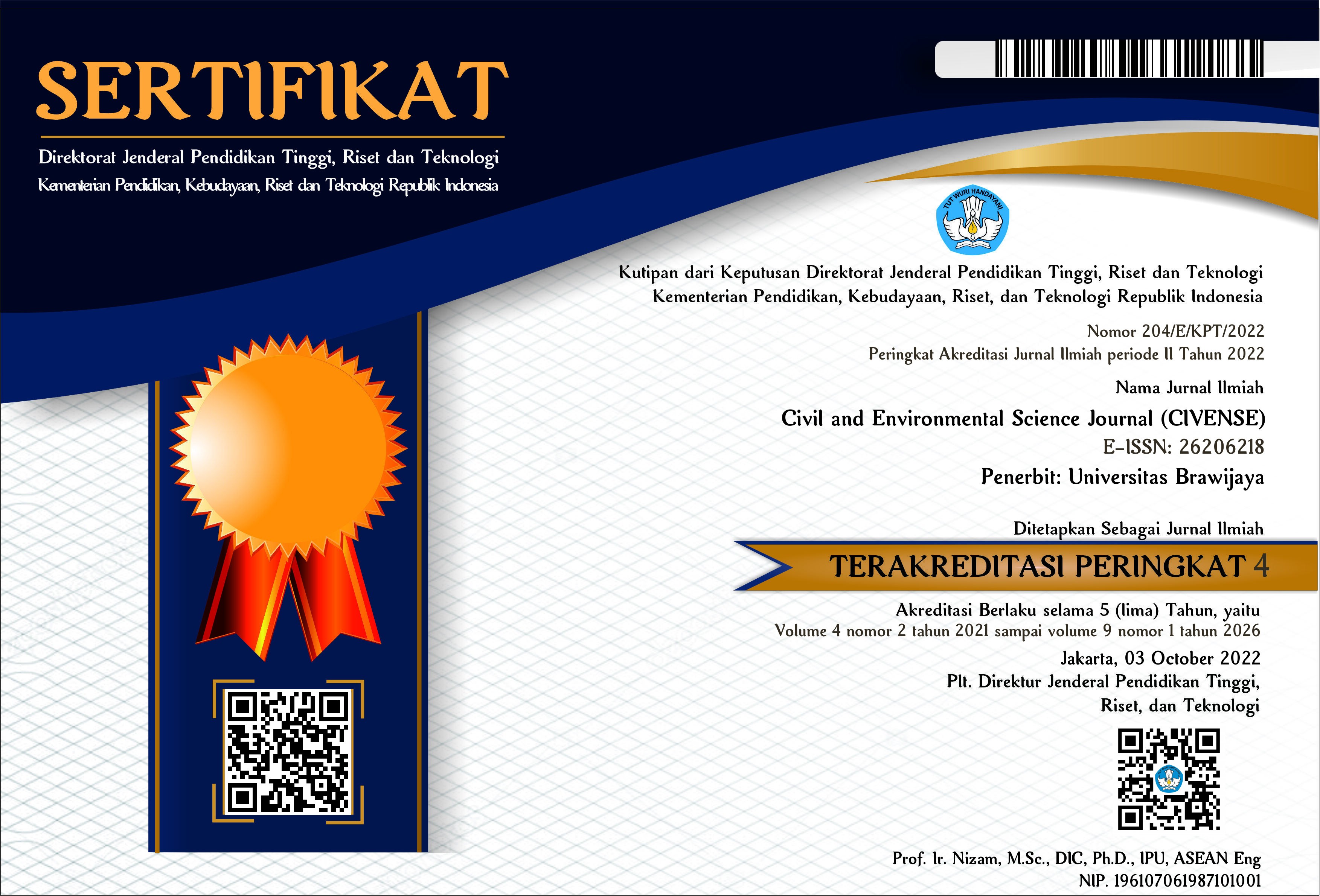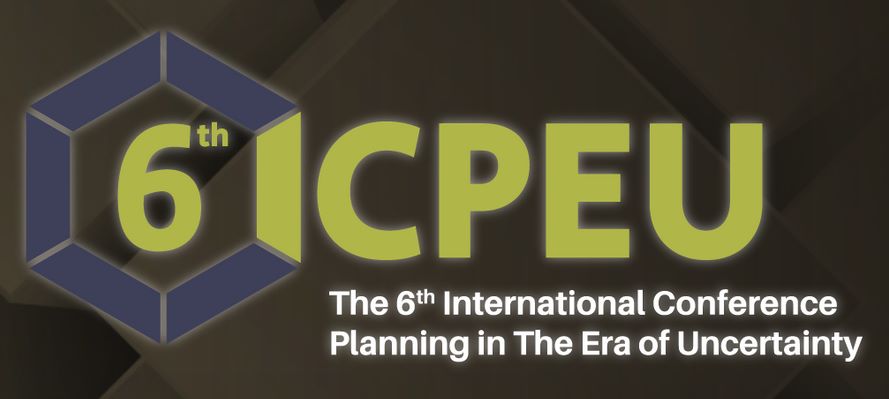Estimation of Flow Discharge Model at Temef Watershed - East Nusa Tenggara Using TRMM Satellite Data
DOI:
https://doi.org/10.21776/ub.civense.2021.00402.2Keywords:
Artificial neural network, flow discharge, TRMM JAXAAbstract
Data collection based on satellite TRMM (Tropical Rainfall Measuring Mission) presents one of the good alternatives in estimating rainfall. TRMM technology can minimize manual rainfall recording errors and improve rainfall accuracy for hydrological analysis. The analysis method used in this research is divided into 3 (three) stages, namely Hydrology analysis, Statistical Analysis and Artificial Neural Network Analysis. From the results of TRMM JAXA analysis in the Temef Watershed Area of East Nusa Tenggara Province obtained TRMM JAXA satellite rainfall relationship to observation data shows rainfall patterns between the two data are interconnected but for cases with very high observation rainfall, TRMM rainfall data tends to be low. From statistical method analysis, the relationship between observation rainfall and TRMM JAXA rainfall obtained results with a "Very Strong" interpretation indicated by the results of 9 years calibration and 1 year validation where the selected equation is a polynomial equation (y=-0,0123x2 + 1,5553x + 20,222). Rain data correction results simulated with Debit data to see the relationship between rain and discharge that occurred, this analysis using Artificial Neural Network with Backpropagation method, the results showed a "Strong" interpretation where statistically the value of Nash-Sutcliffe Efficiency (NSE) 0.920, the coefficient value of correlation of field discharge and TRMM rainfall is 0,877 % and the relative error occurred is 2,62%.
References
Badan Pusat Statistik (BPS), 2018. Propinsi Nusa Tenggara Timur Dalam Angka, 0215-2223
Earth Observation Research Center (EORC), Japan Aerospace Exploration Agency (JAXA), (2018) USER’S GUIDE FOR Global Rainfall Map in Near-Real-Time by JAXA Global Rainfall Watch (GSMaP_NRT), Version 3.2
Ery Suhartanto, Evi Nur Cahya, Lu’luil Maknun, Analisa Limpasan Berdasarkan Curah Hujan Menggunakan Model Artifical Neural Network (ANN) di Sub Das Brantas Hulu, Jurnal Teknik Pengairan, Vol 10. No 2 (2019), pp. 134-144. DOI https://doi.org/10.21776/ub.pengairan.2019.010.02.07
Harisuseno, D. (2020a). Kajian Kesesuaian Rumus Intensitas Hujan dan Kurva Intensitas Durasi Frekuensi ( IDF ) di Wilayah Kampus Universitas Brawijaya , Malang. Media Komunikasi Teknik Sipil, 26(2), 247–257
Harisuseno, D., Suhartanto, E., & Cipta, D. M. (2020). Rainfall-Streamflow Relationship using Stepwise Method as a Basis for Rationalization of Rain Gauge Network Density. International Journal of Recent Technology and Engineering, 8(5), 3814–3821. https://doi.org/10.35940/ijrte.e6617.018520
Harisuseno, D., Wahyuni, S., & Dwirani, Y. (2020). Penentuan Formulasi Empiris Yang Sesuai Untuk Mengestimasi Kurva Intensitas Durasi Frekuensi. Jurnal Teknik Pengairan, 11(1), 38–48. https://doi.org/10.21776/ub.pengairan.2020.011.01.06
Harisuseno. (2020). Meteorological Drought and its Relationship with Southern Oscillation Index (SOI), Civil Engineering Journal, Vol. 6, No. 10, pp. 1864–1875.
Hasihardaja, Sugeng (2005) Pemodelan Curah Hujan-Limpasan Menggunakan Artificial Neural Network (ANN) dengan Metode Backpropagation, Civil Engineering Journal Vol.12 No 4.
Lufi Suryaningtyas, Suhartanto Ery, Rispiningtati, Hydrological Analysis of TRMM (Tropical Rainfall Measuring Mission) Data in Lesti Sub Watershed, Jurnal, Vol 3. No 1 (2020), pp. 18-30 DOI https://doi.org/10.21776/ub.civense.2020.00301.3
Mamenun et al (2014) Validasi Dan Koreksi Data Satelit TRMM Pada Tiga Pola Hujan Di Indonesia, Jurnal Meteorologi Dan Geofisika vol. 15 no. 1-2014 : 13-23
Maulana, H., Suhartanto, E., & Harisuseno, D. (2019). Analysis of Water Availability Based on Satellite Rainfall in the Upper Brantas River Basin. International Research Journal of Advanced Engineering and Science, 4(2), 393–398.
Oldeman, R.L., Irsal Las, and Muladi. 1980. The agro-climatic maps of Kalimantan, Maluku, Irian Jaya, and Bali West and East Nusa Tenggara Contrib. No.60. Centr. Res. Inst.Agrc. Bogor.
Priyanto Dwi, 2016 Strategies To Return East Nusa Tenggara As a Source of Beef Cattle, Jurnal Litbang Pertanian Vol 35 No 4 December 2016:167-168
Sahoo, A.K., Shefeld, J., Pan, M., Wood, E.F., 2015. Evaluation of the tropical rainfall
measuring mission multi-satellite precipitation analysis (TMPA) for assessment of
large-scale meteorological drought. Remote Sens. Environ. 159. 181–193.
Syarief Fathoni, Very Dermawan, Ery Suhartanto, Analisis Efektivitas Kerapatan Jaringan Pos Stasiun Hujan Di Das Kedungsoko Dengan Menggunakan Jaringan Saraf Tiruan (Artificial Neural Network), Jurnal Teknik Pengairan, Vol 7. No 1 (2016), pp. 129 – 138.
Tarigan, G, H et al,. (2014) Analisa Prediksi Data Debit Runtun Waktu Menggunakan Jaringan Syaraf Tiruan Algoritma Backpropagation (Studi Kasus Das Indragiri); Jom Engineering Faculty; Volume 1 NO. 2 October 2014.
VD Oktoprianica, E Suhartanto, S Wahyuni, Analisa Curah Hujan Terhadap Debit Limpasan Menggunakan Metode Jaringan Syaraf Tiruan (Jst) Backpropagation Di Das Welang, (2020) Jurnal Teknik Sipil 9 (2), 301-314.
Welkis et al, (2020), Characteristics of Flood Water Level Based on Hydrologic Soil Group Analysis in Temef Watershed, IOP Conference Series: Earth and Environmental Science, 437 (2020) 012005.
Downloads
Published
How to Cite
Issue
Section
License
Copyright (c) 2021 Civil and Environmental Science Journal (Civense)

This work is licensed under a Creative Commons Attribution-NonCommercial 4.0 International License.
Authors who publish with this journal agree to the following terms:
Authors retain copyright and grant the journal right of first publication with the work simultaneously licensed under a Attribution-NonCommercial 4.0 International License that allows others to share the work with an acknowledgement of the work's authorship and initial publication in this journal.
Authors are able to enter into separate, additional contractual arrangements for the non-exclusive distribution of the journal's published version of the work (e.g., post it to an institutional repository or publish it in a book), with an acknowledgement of its initial publication in this journal.
Authors are permitted and encouraged to post their work online (e.g., in institutional repositories or on their website) prior to and during the submission process, as it can lead to productive exchanges, as well as earlier and greater citation of published work (See the Effect of Open Access).














